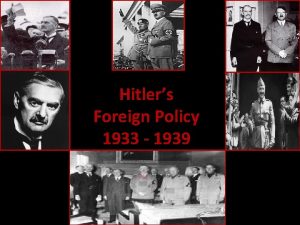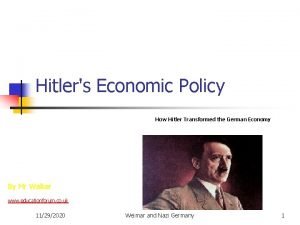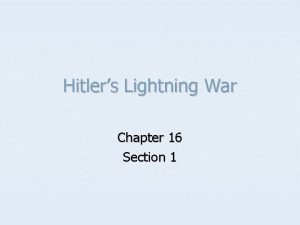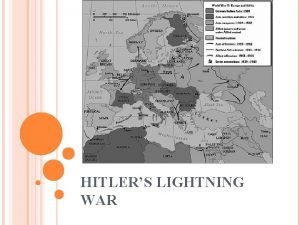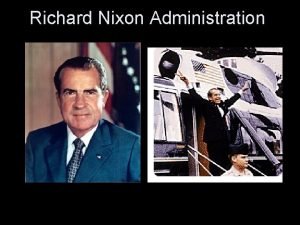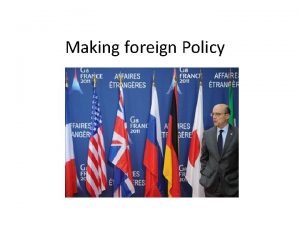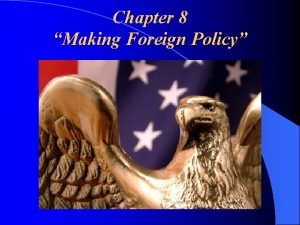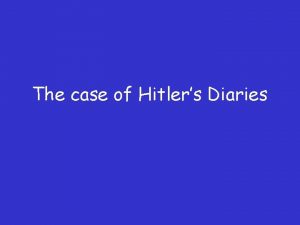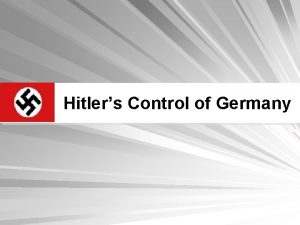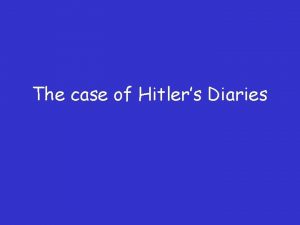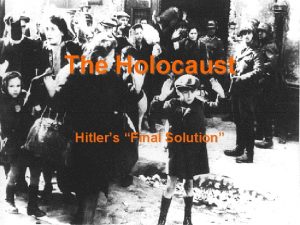Hitlers Foreign Policy Focus How does the foreign














- Slides: 14

Hitler’s Foreign Policy Focus: How does the foreign policy keep the German population happy and thus maintain Nazi support? Link to Factsheet: Foreign Policy Hitler. docx

1. 2. 3. 4. 5. 6. 7. 8. 9. 10. 11. 12. 13. 14. 15. 16. 17. Questions Link to answers: Answers Hitler Foreign Policy. docx Explain how Hitler achieved a ‘reversal’ of the Treaty of Versailles Name two of Hitler’s allies. How did Hitler’s foreign policy maintain support for the Nazis? How did Hitler achieve the Anschluss? How important was the USSR in Hitler’s foreign policy? ‘Hitler always planned to turn on the USSR’ True or False? How much did Hitler manage to increase the German army to? How many Germans had been killed by the end of the Second World War? Why did the German people turn against the war? Describe the Sudeten crisis What happened with the Rhineland? Define Blitzkrieg What were Hitler’s three aims foreign policy? Discuss the importance of Lebensraum in terms of Hitler’s foreign policy What was the final solution? Describe the relationship between Hitler and Mussolini How many Germans died at Stalingrad? How many were taken prisoner? 2

The Theory Of Authoritarian Foreign Policies are a government's strategy for dealing with other nations. The maintenance of power requires the state to be secure against invasion and to meet political promises such as righting historic wrongs and ‘returning’ lands that were taken. Successful foreign policies have the ability to strengthen political power because they gain and / or maintain support

Hitler’s Aims Foreign Policy 1) Tear up the Treaty of Versailles that was signed in 1918 by the ‘November Criminals’ in order to end the First World War. The Treaty had been a thorn in Germany’s collective side since its inception as the people felt they were wrongly punished and blamed for the war. They had been ‘stabbed in the back’ Hitler stated in Mein Kampf that ‘The Treaty of Versailles is engraved on the minds and hearts of the German people and burned into them. Sixty million people will find their souls aflame with a feeling of rage and shame’. 1) Unite all Germans in a single country. This meant bringing Austria, Czechoslovakia and Poland under his control as combined they housed millions of Germans. 1) Provide Germany with Lebensraum (living space). Hitler argued that Germany lacked the space and resources to sustain its current population and therefore needed to gain more ‘living space’ in Eastern Europe at the expense of the ‘inferior’ Slavic peoples of that region. 4

The sources for Hitler’s foreign policy aims: ● ● ● The Twenty-Five Points (1920) Mein Kampf (1924/1925) Hitler’s Second Book (Penned in 1828 but never published) The Four Year Plan Memorandum (1936) The Hossbach Memorandum (1937) Summary Table 5

1934 -1935 Rearmament: -In 1934, Hitler secretly ordered the trebling of the army from 100, 000 to 300, 00 and the building of two pocket battleships and six submarines -In March 1935, Hitler forwent the secrecy and announced his policy of rearmament and revealed that Germany had already begun building an Air Force in breach of Versailles -He reintroduced conscription in order to build his desired army of 550, 000 men -This boosted domestic support because many Germans believed a strong army was vital for Germany’s security and recovering its position as a great power. 1935 The Saar: -In January of 1935, the people of the Saar which had been commandeered by the League of Nations following Versailles, voted by a vast majority for a reunion with Germany. -It boosted Germany’s economy as the Saar was a bountiful coal mining region which in turn increased Hitler’s popularity. ‘Reversing’ the Treaty of Versailles 1936 The Rhineland: -Versailles forbade German soldiers from getting within 50 km of the River Rhine but that did not stop Hitler from ordering his army to march into the Rhineland in 1936 -The gamble paid off. The German army stayed in the area and built up a great line of forts on the France-Belgium border -The ‘West Wall’ meant that France and Britain would struggle to take military action against Germany for breaking Versailles. -The breach was welcomed by most Germans as a restoration of Germany’s full sovereignty. Alliances: -Hitler made a number of foreign alliances, in violation of the Treaty of Versailles -He aided Franco in the Spanish Civil War -He signed the Rome-Berlin Axis Pact with Mussolini, gaining Italy’s support. -He also signed the Anti-Communism Pact with Japan Britain and France were reluctant to take action against Germany’s plans for expansion which allowed Hitler to make serious breaches of Versailles up to 1939 which bolstered support. Most Germans were still angry about the Treaty so any breach was welcomed. 6

Uniting Germans The Anschluss and the Sudeten Crisis 1938 Anschluss with Austria: -The Anschluss was forbidden by the Treaty of Versailles but vital for Hitler’s plan to unite all Germans. -In February 1938, Hitler ordered the Austrian Nazi party to generate as much trouble as possible (parades, marches, arson, bombings, organised fights etc. ) -Hitler met with the Austrian leader following a ban of the party. He threatened invasion unless the Nazis were given the high-power roles in the Austrian government. -Austria organised a plebiscite (a vote) to see whether the people wanted Austria to remain ‘a free and German, independent, Christian and united’ country. -Hitler feared the vote would go against him so he had the Austrian leader sacked and replaced with a Nazi who immediately invited the German troops into Austria. -The Anschluss was proclaimed on March 12 th and, in a vote, 99% expressed their approval. -Neither Britain nor France resisted Hitler. Mainly because many of their populations, well as most Germans regarded Hitler’s desire for a Greater Germany as reasonable. 1938 -1939 The Sudeten Crisis: -Hitler saw the Czechs as an inferior race and had resented them since his youth. -Czechoslovakia was created by the despised 1919 -1920 peace settlement and was home to over 3 million Sudeten Germans who Hitler believed had been denied the right of self-determination. -It was clear Hitler wanted an excuse to invade and destroy the country. -He encouraged the Sudeten German party to keep raising its demands to prevent an agreement between the Czech government and the Sudeten Germans. -Britain's Prime Minister Neville Chamberlain tried to appease Hitler in order to maintain peace. -After two meetings with Hitler, Chamberlain appealed to Mussolini who persuaded Hitler to attend a conference in Munich. -Neither the Czechs nor their ally the USSR were invited -It was decided that Hitler would occupy the Sudetenland in stages and the Czechs were forced to agree -In March, 1939, Hitler seized the rest of Czechoslovakia. -Hitler also demanded the return of Memel (a city taken from Germany under Versailles) from Lithuania.

Uniting Germans The Anschluss and the Sudeten Crisis

The Nazi-Soviet Pact The fallout with the USSR 1939 The Nazi-Soviet Pact: -Germany and the USSR signed the Nazi-Soviet Pact on the 23 rd of August, 1939. -It came as a huge shock to Britain and France -Stalin was seeking to buy time in order to build up his army before the -inevitable- war with Germany -The Pact contained a secret agreement that Russia and Germany would divide Poland between them and Russia would be given permission to seize Estonia, Latvia and Lithuania and certain territories from Finland Romania. -Hitler hoped the Pact would deter Britain and France from defending Poland if it did not, at least it would prevent a war between Germany and Russia. The fallout with the USSR: -Hitler had always wanted to see Germany expand eastwards to gain Lebensraum or 'living space' for its people. After the fall of France, Hitler ordered plans to be drawn up for an invasion of the Soviet Union. He intended to destroy what he saw as Stalin's 'Jewish Bolshevist' regime and establish Nazi dominance -On 22 nd June of 1941, 3 million Axis troops invaded the USSR. The Soviets were unprepared and the Germans got within 40 km of Moscow before the Russian Winter and a masterful counterattack stopped them. This was Operation Barbarossa. -In late 1942, the Russians launched a great counter-offensive, trapping the German Sixth Army at Stalingrad and forcing their surrender in January of 1943. -About 10, 000 Germans died at Stalingrad and 93, 000 were taken prisoner. -In 1944, the Red Army drove the Germans mostly out of Eastern Europe as they advanced on Berlin. -In February of 1945, Russian troops invaded Germany and by April they had besieged Berlin -From 1942, the war in Russia became a long drawn out affair that the German economy was not equipped to handle. -Stalingrad especially was a great material and psychological blow to the Germans. -This reduced Hitler’s popularity amongst the Germans who believed that the money would have been better spent domestically.

War with France and Great Britain The invasion of Poland the beginnings of Blitzkrieg 1939 The Polish Crisis and Invasion: -In March of 1939, Britain signed a treaty where they promised to defend Poland in the case of invasion. -Empowered by this, the Poles turned down Hitler’s demand for Danzig -In April, Britain expanded its conscription (to 20 and 21 year olds) -In order to undermine Britain’s fighting will, Hitler began by only demanding the return of Danzig and rail and road access across the Polish Corridor. -Hitler’s generals were ordered to plan an attack on Poland. -Hitler secretly approached the USSR for an alliance. -On 1 st September 1939, Germany invaded Poland -On 3 rd of September, Britain and France declared war on Germany -The Poles were swiftly defeated by the Germans and the Russians and they surrendered in October. -Britain and France refused to concede and as a result Hitler was faced with a major European war earlier than he intended. The Beginnings of Blitzkrieg: an intense military campaign intended to bring about a swift victory -After failing to negotiate peace with the Allies, Hitler decided that before he attacked the USSR, he needed control over Western Europe. -In the first half of 1940, Hitler organised a mass invasion campaign: In April, Denmark and Norway were overrun by German forces, in May it was Holland, Belgium, Luxembourg and France. By June, France was the only one still standing and they surrendered on the 22 nd following the invasion of Italian troops. -Mussolini joined Hitler in war on June 10 th. -The Battle of Britain occurred between July and September of 1940. -It was a result Churchill’s defiance and refusal to negotiate peace. Hitler decided he needed to invade Britain and knock her out of the war before he attacked the USSR. -It was a failure. The Luftwaffe did not achieve control of British skies. -Britain was left undefeated -Hitler’s spectacular victories were extremely popular in Germany 10

1941 The Involvement of the US: -On December 11 th, 1941, Four days after the Japanese attack on Pearl Harbour, Hitler declared war in the USA. -The US had been supplying Britain and Russia with vital war materials. -With this declaration Germany had officially taken on two of the most powerful countries in the world. -Bringing in the US was arguably one of Hitler’s biggest mistakes. The Worsening of War US Involvement and The Final Solution The Worsening of War: -Early in the war, Hitler discovered that Mussolini was more of a liability than an asset as evidenced by his failed campaigns in North Africa and the Balkans. -Hitler felt obliged to aid Italy which delayed his attack on the USSR until 1941 which is arguably a reason for its failure -The German Navy was tasked with starving Britain into surrender by sinking supply ships into the Atlantic. This failed and Britain held out until the US arrived. -In 1942, the pendulum of war began to swing against Germany; the tide had turned. -By May of 1943, North Africa was fully under US and British control -The German failure at Stalingrad proved how much Russian military leadership and capability had improved since 1941. -In the summer of 1943, Italy was invaded by US and British forces which essentially took Mussolini out of the game. The Final Solution and the End of the War: -It is unclear when exactly Hitler decided to murder Europe’s Jews. The decision was probably made sometime in 1941, with the invasion of the Soviet Union. -On January 20, 1942, Reinhard Heydrich, the chief of Germany’s Security Police, held a secret meeting known as the Wannsee Conference where leading police and civilian officials discussed the continuing implementation of the "Final Solution. " -The Nazi leaders envisioned killing 11 million Jews as part of the “Final Solution. ” They succeeded in murdering 6 million. -On April 30 th, Hitler committed suicide and Germany surrendered in May -Goering and other leading Nazis were captured and tried at Nuremberg. -They were sentenced to either death or prison terms for war crimes. -By the end of the Second World War, 4. 5 million Germans had been killed and 6 million of Europe’s Jews had been exterminated in the Holocaust.

The Road To War:

Overall. . . Hitler achieved two of his foreign policy aims but not the third. -He successfully ‘reversed’ the Treaty of Versailles to the point where the German people were content with the size of Germany’s armed forces and the reclamation of the land they had lost (most notably the Saar and the Rhineland). All though the sting of the War Guilt clause remained, the people believed Hitler had fulfilled his promise. -Hitler also successfully united Germans. He got the desired Anschluss with Austria, was able to take out Czechoslovakia and got Memel returned to Germany. Most Germans regarded Hitler’s desire for a greater Germany as reasonable and were happy about the expansion. However, Hitler failed to permanently achieve Lebensraum. At various stages in the Second World War, Germany was in control of more countries but, every time, Hitler failed to keep them. As the war raged on, the German people became more and more disgruntled with Hitler. The war was costly in both materials and life and did not seem to be getting Germany anywhere. 13

1. 2. 3. 4. 5. 6. Past IB Exam Questions Evaluate the foreign policy of two rulers of single-party states, each chosen from a different region. Explain the aims and direction of foreign policy in your chosen state? How did world events shape the foreign policy? Explain the relationship between allies and enemies of the state. Examine the successes and failures of the foreign policy? To what extent did the foreign policy change over time? 14
 Hitlers foreign policy
Hitlers foreign policy Hitlers economic policy
Hitlers economic policy Hitlers lieblingslied
Hitlers lieblingslied Chapter 16 section 1 hitlers lightning war
Chapter 16 section 1 hitlers lightning war Who were hitlers parents
Who were hitlers parents Hitlers lightning war
Hitlers lightning war Prolepsis
Prolepsis Integrated cost leadership/differentiation strategy
Integrated cost leadership/differentiation strategy Business level strategy cost leadership
Business level strategy cost leadership Actor focus vs object focus
Actor focus vs object focus Here you are too foreign for home
Here you are too foreign for home 1790 foreign policy
1790 foreign policy Foreign policy of louis philippe
Foreign policy of louis philippe What was thomas jefferson foreign policy
What was thomas jefferson foreign policy Nixons foreign policy
Nixons foreign policy
